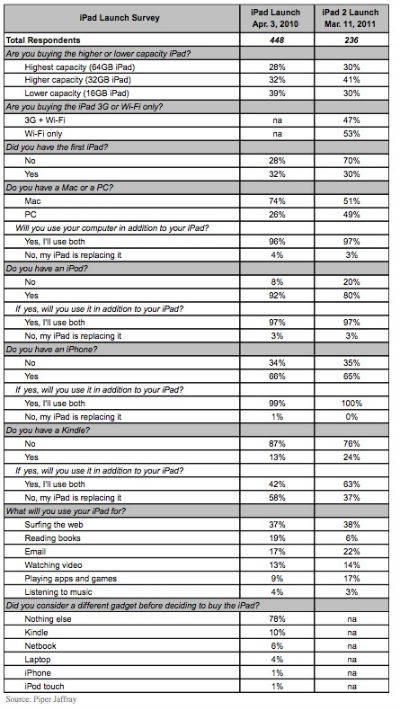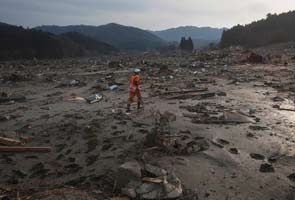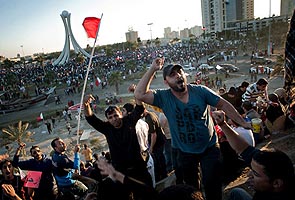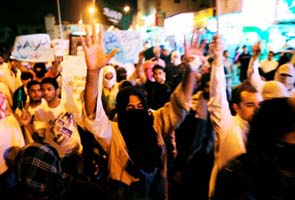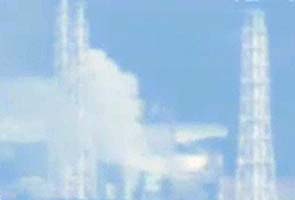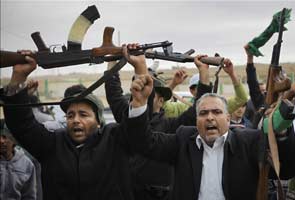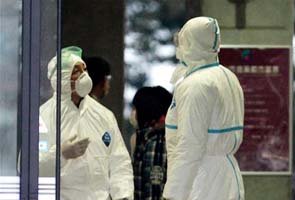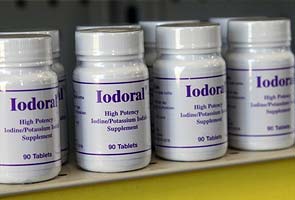Tokyo: Anxiety mounted in Japan on Tuesday as the country struggled to come to grips with the scope of the natural disaster that struck last Friday and the nuclear crisis it unleashed.
The National Police Agency said Tuesday afternoon that, so far, 2,722 people were confirmed to have died in the earthquake and tsunami, and many thousands remained missing. Bodies continued to wash ashore after having been pulled out to sea by the tsunami's retreat. A brief ray of hope pierced the gloom on Tuesday, when two people were rescued from collapsed buildings after being trapped for more than 90 hours.
Some 400,000 people were living in makeshift shelters or evacuation centres, officials said. Bitterly cold and windy weather descending on northern Japan compounded the misery as survivors endured shortages of food, fuel and water.
The threat of radiation exposure from a deepening crisis at Japan's stricken nuclear plants intensified the dislocation and fear sweeping the nation. The third reactor blast in four days on Tuesday morning at the Fukushima Daiichi Nuclear Station pushed up radiation levels in the air over Tokyo, where some residents made plans to leave the city while others began to buy and stockpile food, water, candles and batteries.
Shelves at grocery stores were stripped bare. Prime Minister Naoto Kan went on national television to implore people not to panic.
The government ordered all 47 prefectures in Japan to begin making radiation-level test results public twice daily and to alert national authorities quickly if they detect elevated levels.
Though prevailing winds have so far blown leaked radioactive material out over the Pacific Ocean rather than back toward the Asian mainland, Chinese health and environmental officials held urgent meetings on Tuesday about how to respond if radioactive fallout reaches China. "Definitely, China has several levels of contingency plans," said Zhang Wei, an official at the National Institute for Radiological Protection.
Nations like South Korea and Singapore said they would step up inspections of food imported from Japan.
There were scattered news reports of some foreigners fleeing Japan, and one Western diplomat said Tuesday night that "anecdotes and rumours" were swirling in the international community.
A number of airlines suspended service to Tokyo and northern cities closer to the stricken nuclear plant, or relocated their flights and employees to airports in southern Japan. One foreign manufacturer, BMW, said it had relocated its 800 employees away from the disaster area to southern Japan or to Germany. The Austrian embassy moved temporarily to Osaka from Tokyo, and French officials advised their citizens to leave Tokyo.
Still, there appeared to be no mass exodus. The United States Embassy, for example, was not urging resident Americans to leave the country, though it was advising travellers not to go to Japan for now. And the mood on the street in Tokyo Tuesday night was concerned and stoic rather than fearful and desperate.
The ambassador, John V. Roos, said that about 1,300 Americans were living in the five northern prefectures most affected by the earthquake and the tsunami. American consular officers were making their way to Sendai and other northern cities on Tuesday to conduct "welfare-and-whereabouts" checks on American citizens there, Mr. Roos said.
The Chinese government said it was preparing to send buses to evacuate Chinese citizens from four prefectures in the north.
In the areas hardest hit by Friday's earthquake and the tsunami that followed, rescue teams from 13 nations, some assisted by dogs, continued to search for survivors.
Japanese news media reported that a 92-year-old man was found alive in a collapsed building in Ishinomaki City and a 70-year-old woman in the wreckage of her home in Iwate Prefecture. In the air, helicopters shuttled back and forth, part of a mobilization of some 100,000 troops, the largest in Japan since World War II, to assist in rescue and relief work.
The United States Geological Survey revised the magnitude of the earthquake to 9.0, from 8.9, but it was the subsequent tsunami that did the most damage. The initial wave scoured away entire communities, and desperate survivors searched Tuesday for signs of friends and relatives who remained missing.
There was plenty that was missing in the fishing village of Minamisanriku: the city hall, the hospital, the shipyard, police stations -- and 8,000 people.
The tsunami might have crashed most heavily into this town, which once was home to more than 17,000. Situated at the head of a V-shaped cove bracketed by mountains, the town was swamped by a surge of muck and seawater that rose to 30 feet high.
As the deluge pressed in on the town, Sanae Sato, 71, said that 400 people rushed to the community centre where she worked. They thought the five-story building would be tall enough to protect them. But when the water reached the fourth floor, they all sought shelter in the attic.
From the attic window, Ms. Sato said, she saw the floodwaters hurling cars along, with drivers and passengers still inside. Houses broke from their foundations and were carried along; their owners perched on the ridges of the roofs.
"I saw people trying to balance on the rooftops like surfers," she said. "It didn't work. It was like hell."
The Miyagi prefectural government said on Tuesday that search teams had located 2,000 people in Minamisanriku who had been unaccounted for. They had fled to surrounding towns as the tsunami bashed the coastal areas of the town.
Soldiers worked to clear roadways into the village on Tuesday as a long line of fire trucks waited to enter. Closer to shore, teams of searchers rummaged through the crushed houses and collapsed shops. They peered into cars that had been swallowed by the mud, hoping to find survivors. Searched cars were marked with yellow tape.
One gruesome discovery was a mud-caked woman hanging by her head from the roof of a gas station. She was brought down, covered in a blue plastic tarp, and her body was laid by the station to await collection by another disaster team.
As it struggles to cope with the disaster at the nuclear power station, Tokyo Electric also had to deal with the loss of the power that the plants produced. The company announced plans for rolling blackouts across the region to conserve electricity -- the first controlled power cutbacks in Japan in 60 years.
The first set of blackouts Tuesday morning began in four prefectures outside Tokyo. The utility, which provides service to 45 million people in the region, said the cuts could continue for six weeks. Public conservation of electricity was significant enough, the company said, that plans for more drastic blackouts were being scaled back.
The radiation reports, the power cutbacks and continuing aftershocks and smaller earthquakes -- including a 6.0-magnitude shake on Tuesday evening -- were enough to prompt some Tokyo residents to seek perceived safety further south.
"I'm a little scared," Yuko Ota, 38, an office worker, said Tuesday as she stood in a long line at Meguro Station in central Tokyo for a ticket to Osaka, her home town.
"My company told me to go back now because they think the disaster will have an impact in Tokyo, and the earlier we go, the better," she said. "So for one week, to begin with, the whole company is either staying home or going away. I'm lucky, because I can go be with my parents."
Ben Applegate, 27, an American freelance translator, editor and tour guide, said he and his girlfriend, Winnie Chang, 28, of Taiwan, left Tokyo to stay with his former host family in the ancient capital of Kyoto.
"I realize that everything is probably going to be fine," he said, but the combination of a forecast for another major quake, which has since been revised downward, and the nuclear accident had been a strong incentive to leave. "Plus, our families were calling once every couple of hours," he said. "So we thought everyone would feel better if we went to Kyoto."
Gemma Nokes, 32, a British recruitment consultant, said she had weighed the information and decided she wanted to get away for a few days. "I'm heading down to Nagoya with a friend," she said, referring to Japan's fourth-largest city. "It's a precautionary measure." She said she knew French and American people who had left for Singapore or Hong Kong to wait out the news.
Still, the vast majority of Tokyoites were staying put and carrying on. Typical was the reaction of a young Japanese man in a leather jacket waiting outside the station. Asked if he was leaving because of the radiation danger, he shrugged and laughed, but declined to explain.
Edmund Harbord, 30, and his friend Sam Illingworth, 27, both British physicists who live in Japan, said that as far as they were concerned, nothing had changed since Saturday, when the problems first became evident.
"Japan's government has been slow to get the news out, and the Western media are jumping to conclusions," Mr. Harbord said. "We're absolutely not panicking at all," Mr. Illingworth said.
At the Atré supermarket in Meguro, there were long lines as Tokyoites stocked up on essentials, and store personnel were pressed to keep up the shelves stocked. A manager, nervous to be seen talking with a reporter, said the fears played a part in the long lines. She added, however, that the store had also been closed for a day because of the power outages, and some customers were probably just catching up.



 Jerusalem: Over 80,000 documents of the Albert Einstein archives at the Hebrew University of Jerusalem would now be digitised.
Jerusalem: Over 80,000 documents of the Albert Einstein archives at the Hebrew University of Jerusalem would now be digitised.  Fukushima: Japan suspended operations to prevent a stricken nuclear plant from melting down Wednesday after a surge in radiation made it too dangerous for workers to remain at the facility.
Fukushima: Japan suspended operations to prevent a stricken nuclear plant from melting down Wednesday after a surge in radiation made it too dangerous for workers to remain at the facility.  There are six reactors at the plant, and three that were operating at the time have been rocked by explosions. The one still on fire was offline at the time of the magnitude 9.0 quake, Japan`s most powerful on record.
There are six reactors at the plant, and three that were operating at the time have been rocked by explosions. The one still on fire was offline at the time of the magnitude 9.0 quake, Japan`s most powerful on record. 


